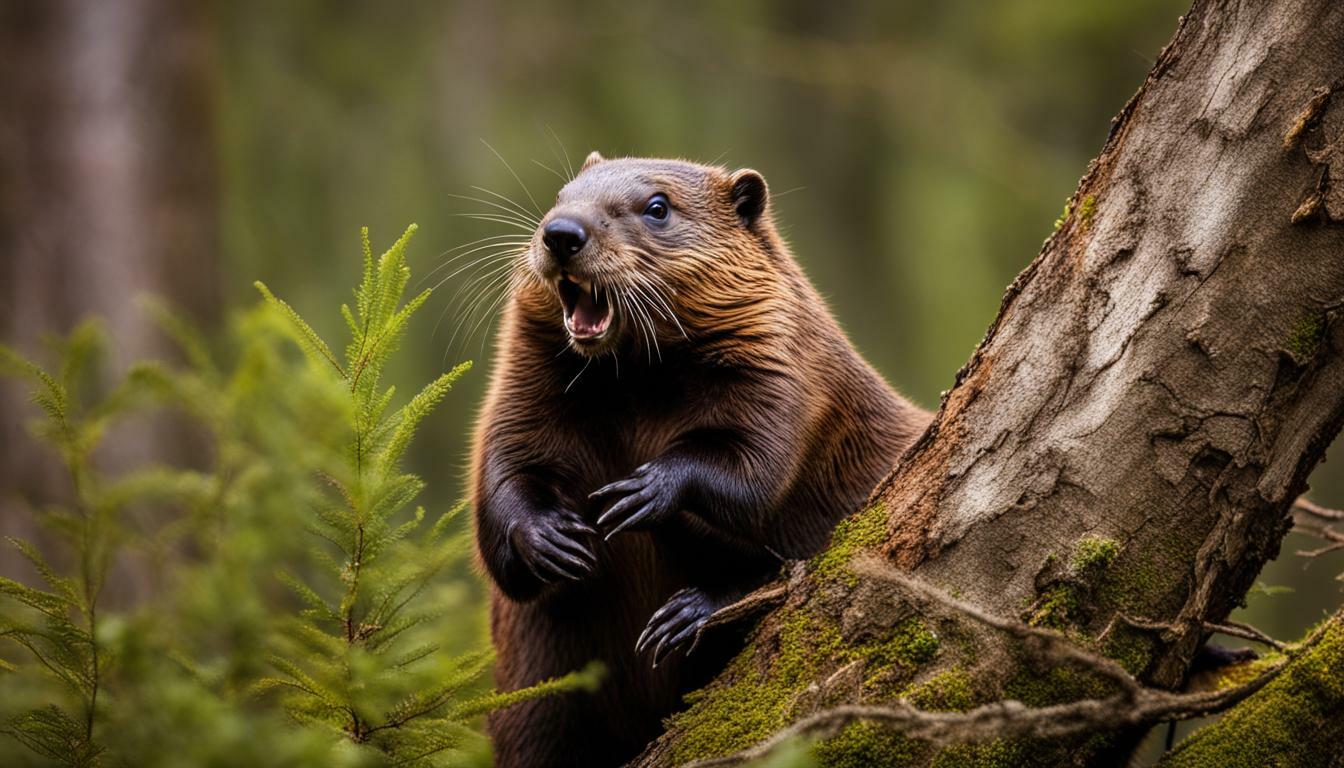Have you ever wondered why beavers have a habit of chewing on trees? These industrious creatures engage in this behavior for a variety of reasons. Not only do they use trees for food, but they also rely on them for building materials to construct their dams and lodges. Let’s delve deeper into the intriguing world of beaver behavior and discover the significance behind their tree chewing habits.
Key Takeaways:
- Beavers chew on trees for food and building materials.
- Their strong teeth and powerful jaw muscles allow them to chew through tree trunks.
- Beavers’ teeth are constantly growing, so they need to gnaw on wood to prevent overgrowth.
- They consume the inner layer of tree bark and the softer layers of wood, but not the actual wood itself.
- Beavers prefer certain tree species, such as aspen, cottonwood, and willow.
As we explore the fascinating world of beavers, we’ll uncover more about their diet, their impact on ecosystems, and the delicate balance between human interests and conservation efforts. Let’s embark on this captivating journey to gain a greater understanding of these remarkable creatures and their vital role in shaping their environment.
The Importance of Beaver Tree Chewing
Beavers’ tree chewing habits serve vital purposes in their survival and habitat construction. These industrious creatures use trees not only as a source of food but also as building materials for their dams and lodges. With their strong teeth and powerful jaw muscles, beavers can chew through tree trunks with impressive efficiency. Their teeth are constantly growing, so they have a natural urge to gnaw on wood to keep their teeth from becoming too long.
When it comes to their diet, beavers have specific preferences. They consume the inner layer of tree bark and the softer layers of wood underneath, leaving the actual wood untouched. This selective eating behavior allows them to extract the nutrients they need while preserving the structural integrity of the trees. Beavers tend to favor certain tree species, such as aspen, cottonwood, and willow, which provide them with the ideal food source.
| Common Tree Species Preferred by Beavers |
|---|
| Aspen |
| Cottonwood |
| Willow |
Beavers’ tree chewing habits not only satisfy their dietary needs but also have a significant impact on their environment. They play a key role in the creation of wetland ecosystems by constructing dams across rivers and streams. These dams alter the flow of water, reducing erosion and creating a habitat for numerous other animals. The wetlands serve as a source of food and protection for beavers, while also benefiting species that depend on these unique habitats.
The Seasonal Patterns of Beaver Tree Cutting
Beavers exhibit distinct patterns in their tree chewing activities, with heightened cutting occurring in the fall. During this time, beavers work diligently to stockpile a food cache for the winter months. This behavior ensures their survival during periods when food may be scarce. By strategically selecting trees and diligently cutting them down, beavers show remarkable resourcefulness in preparing for the challenges of winter.
In summary, beavers’ tree chewing habits have far-reaching implications for both their own survival and the ecosystem they inhabit. Their ability to utilize trees for food and construction, combined with their role as habitat modifiers, makes them fascinating creatures with a profound impact on their environment. Understanding and appreciating their importance is essential for conservation efforts and maintaining the delicate balance of nature.
Beavers and Their Teeth
The incredible teeth of beavers are perfectly adapted for their tree-chewing activities. Beavers have strong teeth and powerful jaw muscles that allow them to gnaw through tree trunks with ease. Their front incisors are razor-sharp and continuously growing, which is why they need to constantly chew on wood. By doing so, they keep their teeth from becoming too long.
The dental structure of beavers is truly fascinating. They have two pairs of incisors – one on the top and one on the bottom – that are designed to self-sharpen as they grind against each other. The enamel on the front of their teeth is hard and orange, while the back of their teeth is softer and made up of dentin, a material similar to our own teeth. This unique combination allows beavers to efficiently chew through even the toughest tree trunks.
As beavers chew on trees, their teeth leave distinctive grooves behind. These grooves can be used to identify beaver activity in an area. Their chewing not only helps them acquire food but also serves a vital purpose in the construction of their dams and lodges. By using their sharp teeth, beavers fell trees and gather building materials, ensuring they have a secure and comfortable home.
| Beaver Teeth Structure | Description |
|---|---|
| Front Incisors | Two pairs of razor-sharp incisors that continuously grow |
| Enamel | Hard and orange, located on the front of the teeth |
| Dentin | Softer material, located on the back of the teeth |
Beavers have truly remarkable teeth that are perfectly suited for their tree-chewing lifestyle. Their constant gnawing not only allows them to acquire food but also shapes their environment by creating new habitats. By understanding the unique dental structure of beavers, we can appreciate the incredible adaptations that enable them to thrive in their natural habitat.
Beavers’ Diet: What They Eat
The culinary preferences of beavers go beyond what meets the eye. These fascinating creatures have a specific diet that plays a crucial role in their survival and habitat modification. While it may seem like beavers simply chew on trees, their preferences and eating habits are more intricate than one might think.
Beavers primarily consume the inner layer of tree bark and the softer layers of wood underneath. This unique diet allows them to access the nutrients they need without actually consuming the tough and indigestible wood. By honing in on these specific parts of trees, beavers are able to extract the necessary sustenance to support their energy requirements.
When it comes to their tree preferences, beavers have certain species that they favor. Aspen, cottonwood, and willow are among the trees that beavers find most delectable. These species offer a tasty and nutritious meal for these industrious creatures. Through their selective choices, beavers not only satisfy their hunger but also shape their surrounding environment.
It is important to note that beavers’ tree cutting activities are not random but follow a seasonal pattern. They are most active in the fall when they gather food to stockpile for the winter months. This behavior ensures that they have enough sustenance to survive during the colder season when food availability may be limited. By maintaining a well-stocked food cache, beavers are able to thrive and maintain their energy levels throughout the winter.
| Beavers’ Diet | Tree Species |
|---|---|
| Inner layer of tree bark | Aspen |
| Softer layers of wood | Cottonwood |
| Willow |
Tree Preferences of Beavers
Beavers have discerning taste when it comes to their tree menu. These industrious creatures carefully select the trees they chew on, favoring certain species that provide them with the best nourishment and building materials for their dams and lodges.
Among the top choices on their menu are aspen, cottonwood, and willow trees. These species offer the beavers the right combination of nutritional value and structural integrity. The soft inner layer of tree bark, known as cambium, and the softer layers of wood underneath are a delicacy for beavers. They skillfully strip away the bark and gnaw through the wood to access the nutritious layers they need for sustenance.
When it comes to tree selection, beavers are not haphazard. They carefully assess the quality and availability of trees in their surroundings. They consider factors such as tree size, freshness, and proximity to water. This discerning approach ensures that beavers have a sustainable supply of food and building materials all year round.
| Preferred Tree Species | Reasons for Preference |
|---|---|
| Aspen | High nutritional value; Easy to chew through |
| Cottonwood | Soft inner bark; Provides essential nutrients |
| Willow | Flexible branches; Ideal for dam and lodge construction |
As beavers engage in their tree chewing habits, they play a vital role in shaping their habitat. By selectively felling trees and utilizing them for food and construction, beavers create diverse wetland ecosystems. These ecosystems provide food and shelter not only for beavers but also for numerous other species, including birds, fish, and invertebrates. The presence of beavers and their tree preferences contribute to the overall biodiversity and ecological balance in their surroundings.
The Seasonal Patterns of Beaver Tree Cutting
Beavers’ tree-cutting frenzy reaches its peak during a specific time of the year. These industrious creatures are most active in cutting down trees in the fall, as they prepare to stockpile a food cache for the upcoming winter months. Fall is a critical time for beavers as they need to gather enough resources to sustain them through the colder season.
The seasonal nature of beavers’ tree cutting is directly linked to their survival instincts and the availability of food. By taking advantage of the abundance of trees during the fall, beavers ensure they have enough food to last them when other food sources become scarce. They focus on cutting down trees with nutrient-rich inner bark, which provides them with nourishment.
During this period, beavers exhibit remarkable skills in identifying and felling trees that meet their dietary and building needs. They prefer certain tree species such as aspen, cottonwood, and willow, which are more palatable and easier to chew. These tree preferences influence the composition of their habitat, shaping the environment for themselves and other species that rely on wetlands.
| Tree Species | Beavers’ Preference |
|---|---|
| Aspen | Favored |
| Cottonwood | Favored |
| Willow | Favored |
Beavers’ tree cutting and selective eating habits serve a vital purpose in their ecosystem. By creating openings in the forest and building dams, they modify their habitat and shape the landscape. These activities have a profound impact on the surrounding environment, altering river flows, reducing stream erosion, and creating wetland ecosystems that support a diverse range of plants and animals.
The seasonal patterns of beavers’ tree cutting showcase their incredible adaptability and resourcefulness. Their ability to manipulate their surroundings for their own benefit while simultaneously benefiting other species highlights the intricate balance of nature. Understanding and appreciating the role of beavers in their ecosystem is crucial for conservation efforts and ensuring the long-term health of our natural habitats.
Beaver Dams and Their Impact
Beavers’ architectural skills shape not only their own lives but also their entire environment. These industrious creatures have a remarkable ability to construct elaborate dams that create a myriad of effects on their surroundings. By building dams, beavers create a network of interconnected ponds and wetlands, transforming the landscape and providing ample benefits to both themselves and other species.
When beavers construct dams, they modify the flow of rivers and streams, redirecting water to create new habitats. The pooling of water behind these structures creates ideal conditions for a variety of aquatic plants and animals. The slow-moving water supports the growth of vegetation, attracting birds, amphibians, and insects. These wetland ecosystems become havens of biodiversity, providing food, shelter, and breeding grounds for numerous species.
Furthermore, beaver dams have a profound impact on the hydrology of their surroundings. The construction of these structures slows down the flow of water, reducing erosion and sedimentation downstream. This, in turn, helps to purify the water and improve its quality. The dams also help to regulate water levels, preventing floods during heavy rainfall and maintaining a steady water supply during dry periods. The intricate network of channels and ponds created by beavers is a testament to their engineering prowess and their ability to shape the natural world.
| Effects of Beaver Dams | Description |
|---|---|
| Creation of Wetland Habitats | Beaver dams create ponds and wetlands that support diverse ecosystems and provide food and shelter for various species. |
| Water Regulation | The dams help regulate water flow, reducing erosion, sedimentation, and the risks of flooding. |
| Biodiversity Support | The wetlands created by beaver dams attract many species, including birds, amphibians, and insects, promoting biodiversity. |
| Water Quality Improvement | The dams slow down water flow, aiding in water purification and maintaining water levels during dry spells. |
Conservation of Beavers
Protecting beavers becomes crucial for maintaining ecological harmony. These industrious creatures play a vital role in their ecosystem by modifying their habitats and creating new ones for other species. By understanding the importance of beavers and implementing conservation measures, we can ensure their continued presence and the preservation of the environmental benefits they provide.
Beaver dams, constructed with meticulous precision, have far-reaching impacts on the surrounding environment. These structures alter the flow of rivers, reducing erosion and sediment transport. By creating ponds and wetlands, beavers increase water storage capacity, which helps mitigate the effects of droughts and floods. Their dams also serve as habitat for a diverse range of plants and animals, adding to the overall biodiversity of the area.
In addition to their engineering prowess, beavers are skilled at tree felling and bark stripping. The trees they chew on provide sustenance and serve as building materials for their lodges and dams. However, it is important to note that beavers do not eat the actual wood. Their selective preferences for tree species, such as aspen, cottonwood, and willow, can impact the composition and structure of local forests.
| Positive Impacts of Beavers | Conservation Strategies |
|---|---|
| Alteration of river flow, reducing erosion | Protect and restore beaver habitat |
| Creation of wetlands, providing habitat for other species | Establish conservation easements |
| Increased water storage capacity, mitigating droughts and floods | Promote beaver-friendly land management practices |
| Enhanced biodiversity in the area | Educate the public on the importance of beavers |
Conservation efforts should focus on protecting beaver populations and their habitats. Establishing conservation easements and promoting beaver-friendly land management practices can help provide a safe and suitable environment for these remarkable creatures. By educating the public on the vital role of beavers in ecosystem restoration and biodiversity conservation, we can foster a greater appreciation for their efforts and encourage their coexistence with human communities.
Beaver Habitat Modification
Beavers are nature’s architects, reshaping landscapes and providing homes for diverse wildlife. These industrious creatures play a significant role in modifying their habitat, creating new wetland ecosystems that benefit numerous other species.
By building dams across streams and rivers, beavers create shallow water bodies known as ponds or wetlands. These wetlands serve as a vital resource for various aquatic plants and animals, providing them with habitat, food, and protection. The dams alter the flow of water, reducing stream erosion and sediment transport. The resulting wetlands become a rich environment, attracting a wide range of species.
Beaver ponds support a diverse community of organisms. Aquatic plants thrive in the still water, creating ideal conditions for amphibians and reptiles. Fish, such as trout and bass, find refuge in the deeper pools created by the dam. Birds, like herons and waterfowl, are attracted to the abundant food resources found in the wetland, while mammals, including muskrats and otters, make use of the waterways for foraging and travel.
| Beneficial Impact of Beaver Habitat Modification | Examples |
|---|---|
| Enhanced Biodiversity | Increased presence of amphibians, reptiles, fish, birds, and mammals |
| Improved Water Quality | The wetland filters sediments and nutrients, improving water clarity |
| Habitat Creation | Creation of multiple microhabitats, including open water, submerged vegetation, and areas with dead wood |
| Flood Control | Reduced downstream flood risk due to water retention |
The beaver’s ability to modify its environment has extensive ecological benefits. These natural engineers contribute to the overall health and functioning of ecosystems, showcasing the intricate interdependencies between species and the delicate balance of nature.
The Fascinating World of Beavers
The world of beavers is a mesmerizing tapestry of environmental impact and diverse interactions. These incredible creatures play a vital role in shaping their ecosystems through their unique behaviors and adaptations. Beavers chew on trees for multiple reasons, using them as a source of food and building materials for their dams and lodges. With their strong teeth and powerful jaw muscles, beavers can chew through tree trunks, thanks to their constantly growing teeth that require regular gnawing on wood to prevent them from becoming too long.
While beavers consume the inner layer of tree bark and the softer layers of wood underneath, they do not eat the actual wood itself since they cannot digest it. They exhibit preferences for specific tree species like aspen, cottonwood, and willow. Fall is a particularly active time for beavers as they cut down trees to stockpile a food cache for the winter months. This behavior not only ensures their survival but also impacts their environment.
| Impacts of Beavers on Their Ecosystem |
|---|
| 1. Dam-building: Beavers construct dams that alter river flow, reducing erosion and creating a habitat for numerous other animals. |
| 2. Wetland creation: These dams create wetlands, serving as a valuable food source and offering protection from predators for beavers and other aquatic species. |
| 3. Habitat modification: Beavers’ activities result in the modification of their habitat, transforming landscapes and providing new habitats for various species. |
Their intricate balance of habitat modification, dam-building, and wetland creation collectively contributes to the overall health and richness of their ecosystems. By creating new habitats and altering their surroundings, beavers foster the growth of biodiversity and positively impact the natural environment.
The Intricate Balance of Nature
Navigating the intricate balance between human needs and the welfare of beavers is of utmost importance. These fascinating creatures, with their ability to modify their habitat and create new wetland ecosystems, have a significant impact on the environment. Beavers’ tree-chewing behavior plays a crucial role in shaping their ecosystem, but it can also lead to conflicts with human activities.
On one hand, beavers contribute immensely to the health and biodiversity of their surroundings. By building dams, they alter the flow of rivers, reducing stream erosion and creating water pools that provide food and shelter for a multitude of species. The wetlands they create act as natural filters, improving water quality and enhancing habitat diversity. Beavers are true ecosystem engineers, and their presence has a positive ecological impact.
However, the effects of beaver activities can sometimes clash with human interests. Their dams may flood roads, agricultural fields, and human settlements, leading to property damage and inconvenience. It becomes necessary to find a delicate balance between the conservation of beavers and the mitigation of potential conflicts.
| Benefit | Challenge |
|---|---|
| Beaver dams reduce stream erosion and improve water quality. | Dams may flood roads and agricultural fields. |
| Wetlands created by beavers enhance biodiversity and provide habitats for various species. | Beaver activities can disrupt human activities and infrastructure. |
| Beavers contribute to the restoration of ecosystems and the conservation of wetland habitats. | Human populations may perceive beaver activities as a nuisance. |
Efforts to conserve beavers and their habitats involve implementing strategies that promote coexistence. This includes the use of flow-controlling devices to prevent flooding, as well as the creation of beaver exclusion fences to protect infrastructure. Educating communities about the ecological importance of beavers can foster understanding and appreciation, leading to more harmonious interactions.
In conclusion, the intricate balance between human needs and the welfare of beavers requires careful consideration. Recognizing the invaluable role that beavers play in shaping their ecosystem and implementing practical solutions to minimize conflicts is crucial. By navigating this balance, we can ensure the preservation of these remarkable creatures and the continued health of our natural environment.
Conclusion
By understanding the reasons behind why beavers chew on trees, we gain a deeper appreciation for their vital role in the natural world.
Beavers chew on trees for a variety of reasons. They use the trees for food and building materials for their dams and lodges. With their strong teeth and powerful jaw muscles, beavers can chew through tree trunks effortlessly. Their teeth are constantly growing, so they need to gnaw on wood to prevent them from becoming too long.
When it comes to their diet, beavers eat the inner layer of tree bark and the softer layers of wood underneath. However, they do not consume the actual wood, as their digestive system cannot process it. They have preferences for certain tree species such as aspen, cottonwood, and willow. These selective choices influence their habitat and contribute to their ecosystem impact.
In addition to their tree chewing behavior, beavers are most active in cutting down trees during the fall season. This allows them to stockpile a sufficient food cache for the winter months. Furthermore, beavers build dams to create wetlands, which provide them with food and protection from predators. These dams have a significant impact on their ecosystem, altering the flow of rivers, reducing stream erosion, and creating habitats for numerous other animals.
Overall, beavers play a crucial role in shaping their ecosystem. Through their habitat modification and creation of new habitats, they contribute to the biodiversity and sustainability of their environment. By understanding their behavior and ecosystem impact, we can better appreciate and conserve these remarkable creatures.
FAQ
Why do beavers chew on trees?
Beavers chew on trees for a variety of reasons. They use the trees for food and building materials for their dams and lodges. Beavers have strong teeth and powerful jaw muscles that allow them to chew through tree trunks. Their teeth are constantly growing, so they need to gnaw on wood to prevent their teeth from becoming too long.
What do beavers eat when they chew on trees?
Beavers eat the inner layer of tree bark and the softer layers of wood underneath. They do not eat the actual wood, as they cannot digest it.
What types of trees do beavers prefer?
Beavers prefer certain tree species such as aspen, cottonwood, and willow.
When are beavers most active in cutting down trees?
Beavers are most active in cutting down trees in the fall to stockpile a food cache for the winter.
Why do beavers build dams?
Beavers build dams to create wetlands, which provide them with food and protection from predators. These dams also alter the flow of rivers, reduce stream erosion, and create a habitat for many other animals.
What is the role of beavers in their ecosystem?
Beavers play an important role in their ecosystem by modifying their habitat and creating new habitats for other species. They are ecosystem engineers that help shape and enhance their environment.




